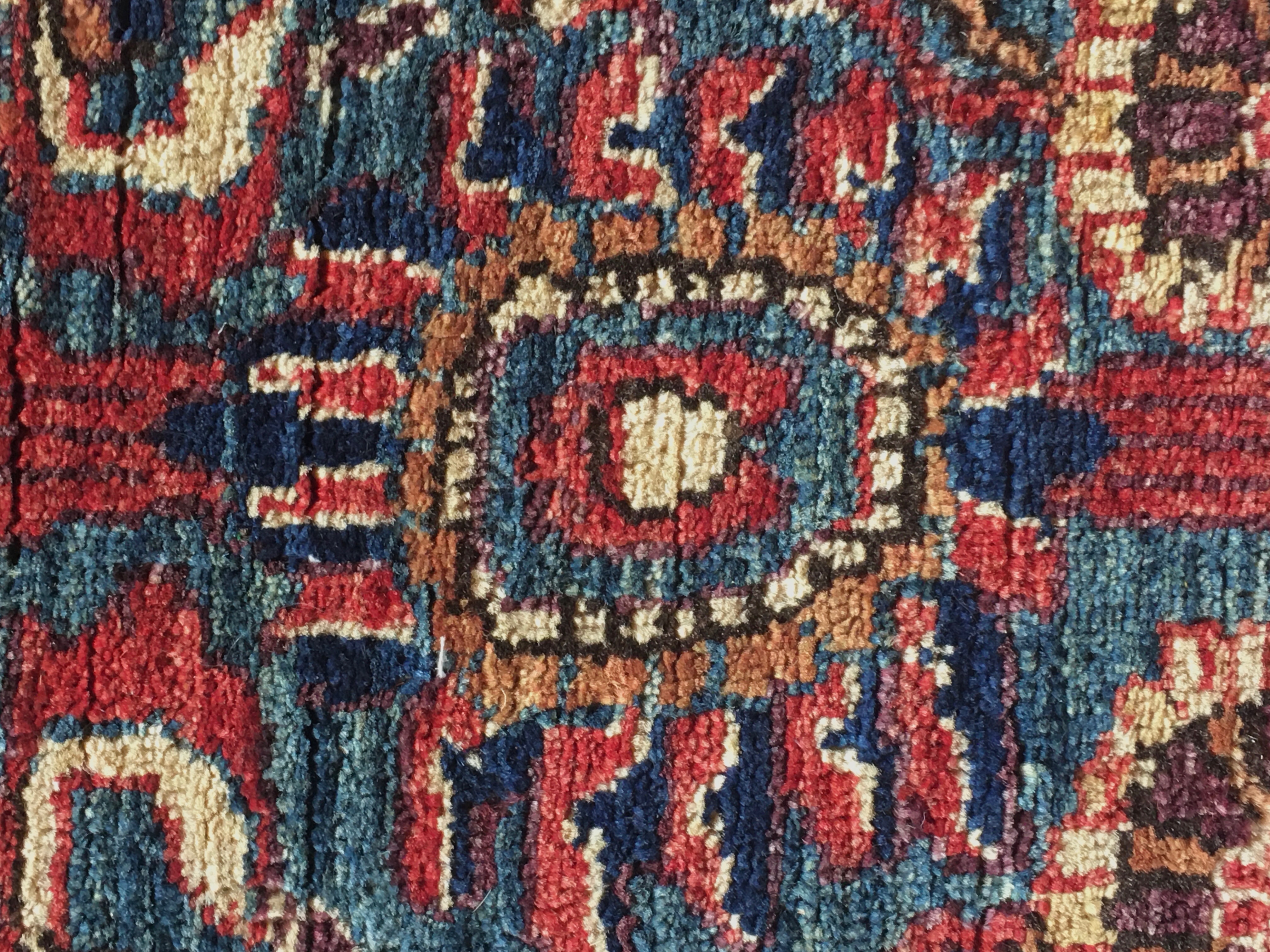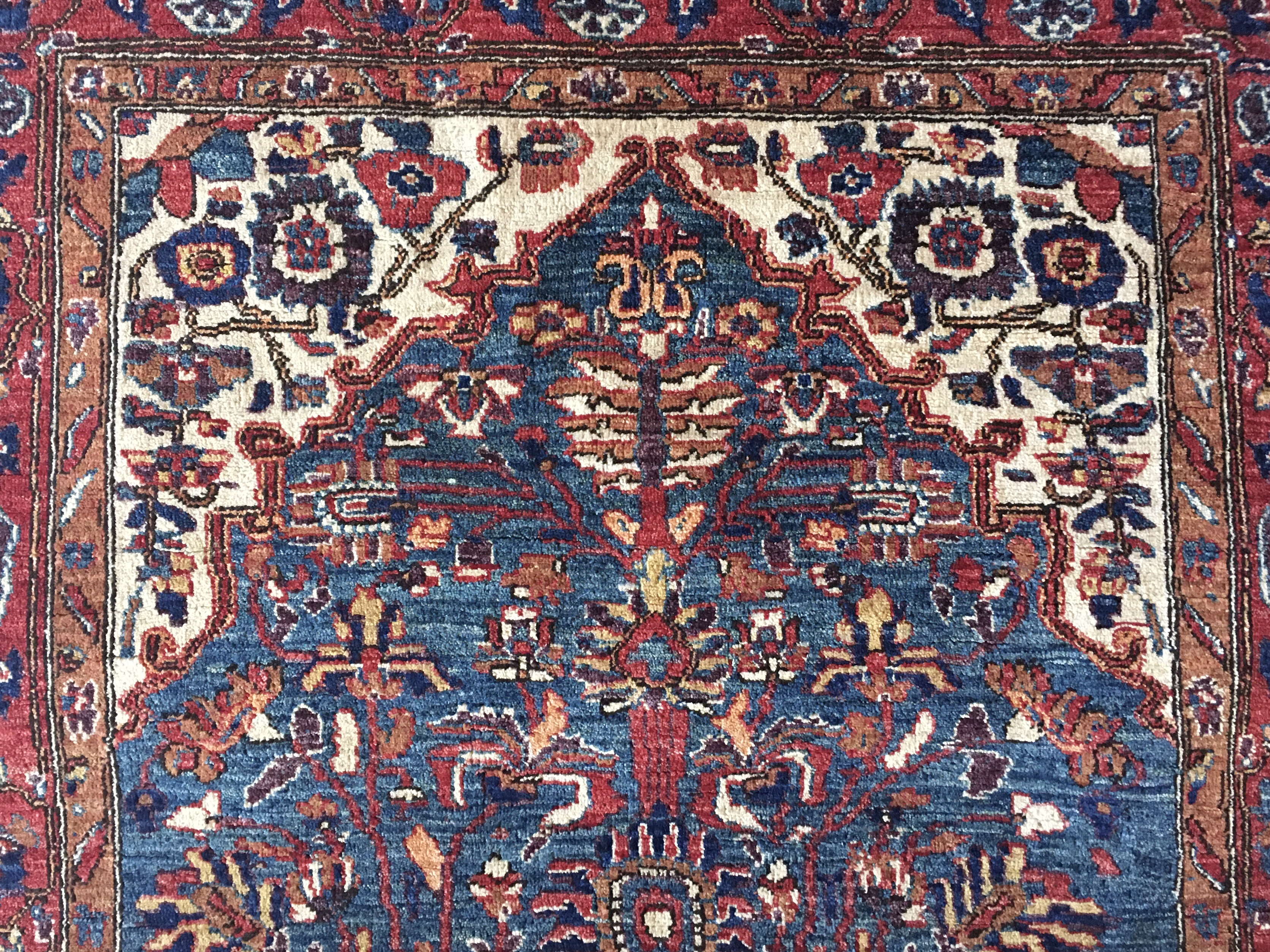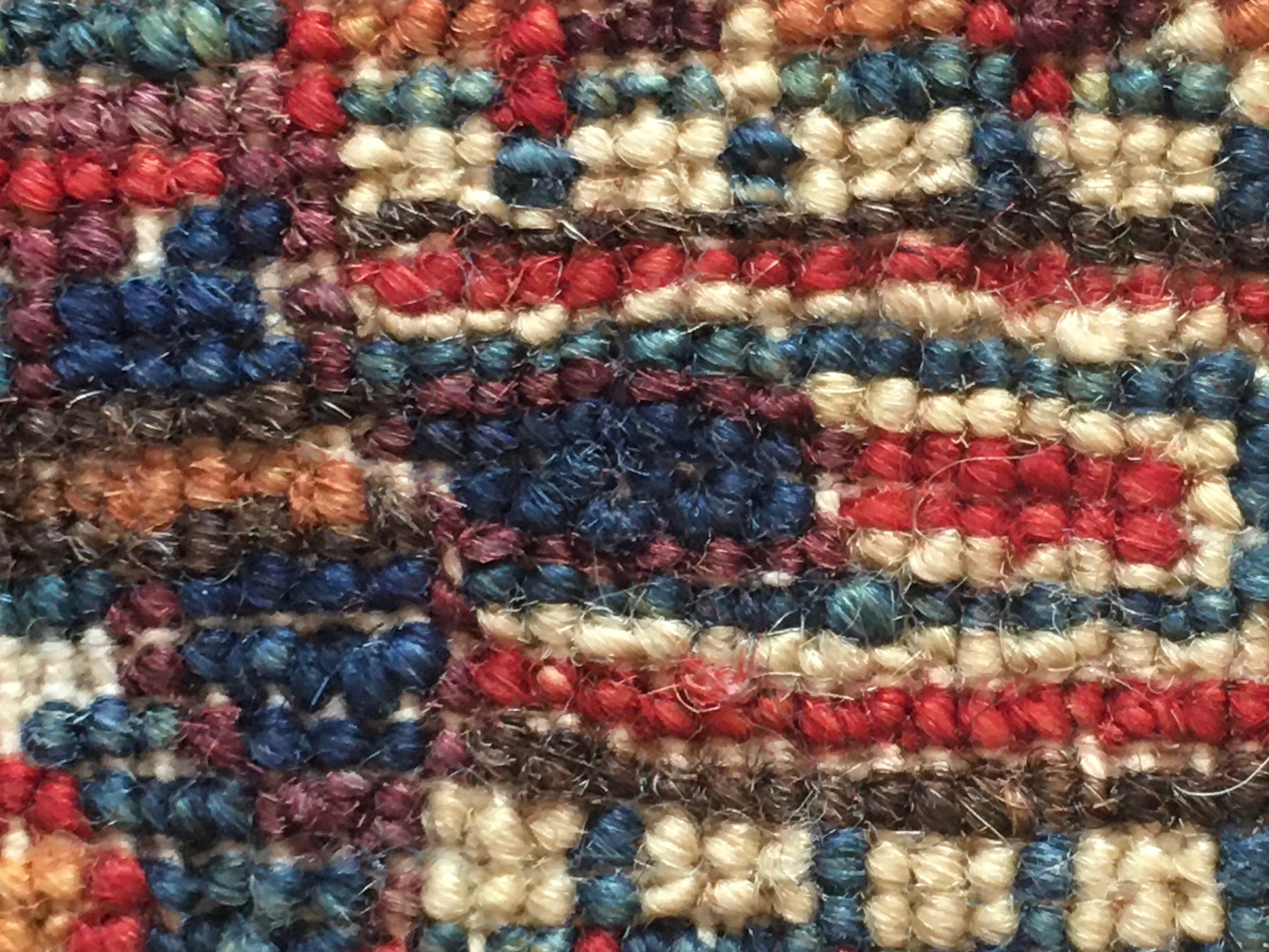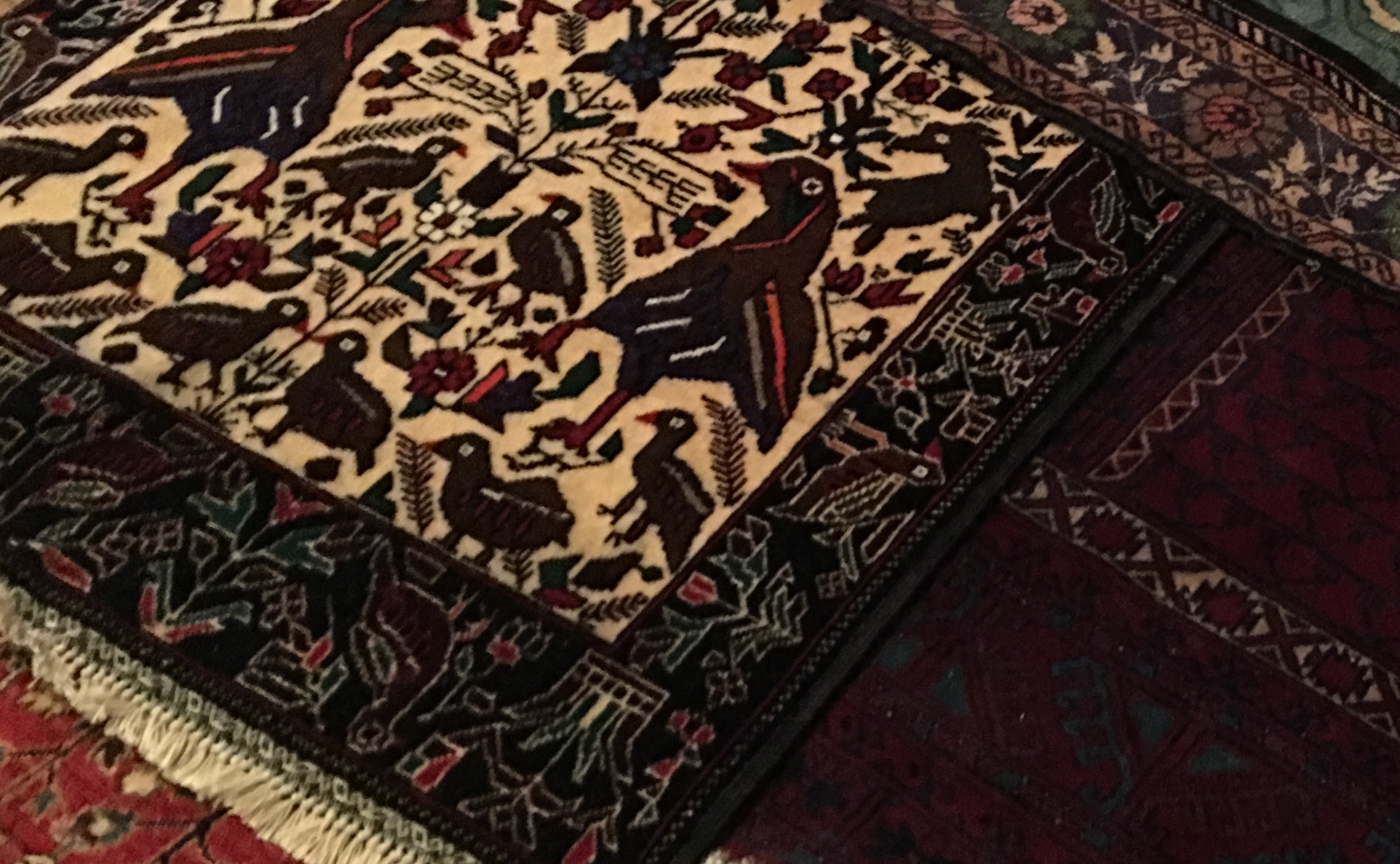
Check here for more information on the homepage rugs.
Nancy Small with Riyaz Bhat

A number of factors contribute to the challenge of fully examining and appreciating nomadic tribal arts, including the locations where nomadic peoples live, the traditional structure of tribal society, and the processes by which the rugs enter into streams of trading. My collaborator, Riyaz Bhat, proved invaluable in sharing his expertise in these areas. Unless otherwise noted, information in this section is from my interview with him (Bhat, personal communication, October 2015).
Tribal communities in Central Asia originate from amid the modern states of Afghanistan, Kazakhstan, Kyrgyzstan, Tajikistan, Turkmenistan, and Uzbekistan; however, tribal life in these areas has changed substantially over the past 400 years as urbanization has pushed people into northern Afghanistan. Tribal families who used to be much more dispersed are now concentrated in smaller areas. More recently—in the past 40 or 50 years—war, inter-tribal hostilities, and unstable economic conditions have channeled nomadic families into a settled lifestyle in cities and towns. As a result, the patterns of nomadic life undergirding the creation of traditional rugs are in decline. Riyaz remarked that changes in living conditions as well as commercialization of carpets production in Iran, India, and Pakistan have led to a division in the craft and market for rugs. On one end of the spectrum are mass-produced modern rugs that are machine made using traditional designs, while on the other end are individually crafted rugs made by tribal people's hands. In other words, tribal rugs are not made in workshops as rugs in Iran or Turkey might be. In the Afghan region, tribal families do not seem to continue weaving if they settle in urban spaces. Instead, they take up other occupations, making the division between mass-market and handcrafted carpets distinct.
Northern Afghanistan is home to a range of tribes, six particularly known for their rug artistry: Baloch, Ghazni, Kazakh, Sherwan, Turkoman, and Uzbekh. Riyaz has visited and learned about all these tribes extensively in both market and camp settings. Tribal communities may be settled, semi-nomadic, or nomadic. Semi-nomadic tribes stay on land they own during the winter, then move to follow grazing fields throughout the rest of the year. An encampment is based on the nuclear family, with an average of three generations living in a system of tents. Because tribal families may include up to eight or 10 children per generation, one family's home may consist of many large tents to accommodate over 100 people and will include dozens of rooms for eating, social gatherings, sleeping, praying, and storage. All these rooms are lined with rugs for warmth and protection against the bitter winter cold as well as decorated with woven wall hangings. Riyaz estimates that one family of 100 people will require approximately 500 rugs for living their daily lives. Rugs range in size from small prayer rugs of 2 feet wide by 3 feet long up to very large rugs measuring 10 by 14 feet.
Although each tribe—indeed, each family—might have smaller individual variations, the basic tradition of rug making is generally consistent. Materials are local to the family, beginning with the sheep. Men and boys shepherd the flock, made of up two breeds, Yaqoob and Karakul, which also serve as a primary source of food. After the men sheer the sheep, women process the wool and spin it on drop spindles. Wool comes in natural colors ranging from white to brown and black and is plied into three types of yarn: one for the warp, one for the weft, and one for the knots. The "threads spun for each function are so different, even when they originate from the same animal, that non–specialists have difficulty in recognizing them as the same fiber" (Spooner, 2011, p. 16). For a rug that is 4 by 6 feet in size, approximately 5 kilograms or 11 pounds of spun wool is required.
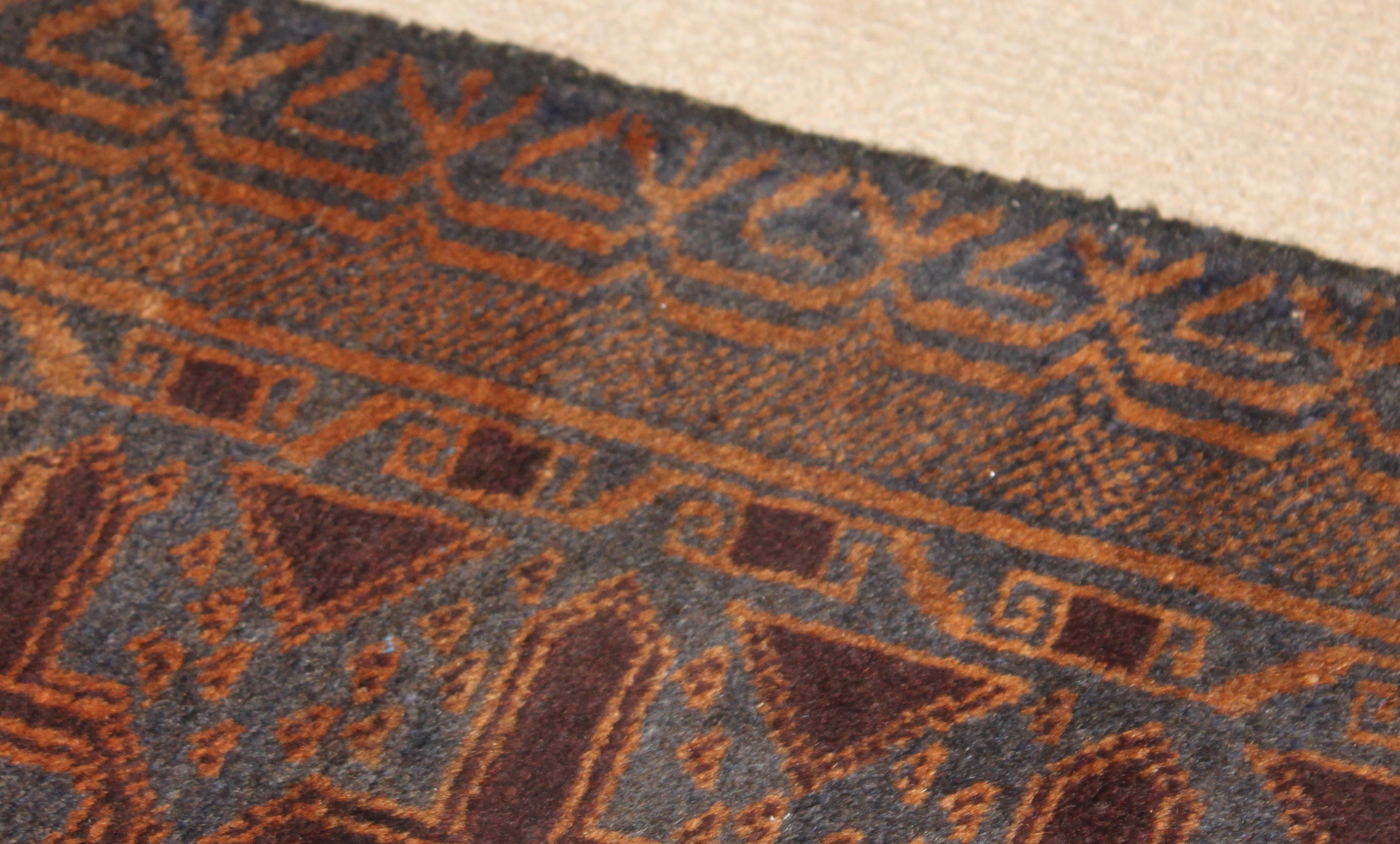
Traditionally, tribes use primarily natural dyes, so women and girls gather flora from the surrounding landscape to create dye baths that color the light or white yarns. Common plants include indigo (blue), madder (red), and saffron (yellow), as well as marigold (yellow), pistachio shell (greenish), and walnut shell (brown to black). Some combination of familial recipe and intuition guides them in this process. A weaver will try to dye enough yarn to finish a project, so the colors are consistent throughout, and the quality and quantity of colors available can factor into the design chosen for a project. Conditions such as drought and minerals in the water can change the colors produced during any given season. Stocks of wool may be dyed in one season and used over the course of many months, and relocation affect the quality of the dye extracted from the plants. Riyaz explained, for example, that madder in a summer location may yield a deep and vibrant maroon, but madder located where the camp moves for the autumn season may be weaker and less pleasing red. If stock runs low for a project, new wool will be dyed for its completion and that new wool may be indicated by a slight variation in color, called "abrash." In sum, the rug's material composition is a complicated combination of materials affected by the environment, location, and climate.
Rugs are woven on wooden horizontal looms constructed according to the size of the item being woven. They may be small enough to use inside the tents or may sit out in the open, covered in wet or harsh weather. Smaller projects, such as prayer rugs, are typically completed by one person, and as the size of the rug increases, more hands are required for its completion. Riyaz has witnessed up to eight women collaboratively working on one project. He described that a large carpet, 9 by 12 feet or bigger, would be a full-time job for eight weavers to finish in a season. Two teams consisting of four craftswomen—two advanced designers and two helpers in training—each will spend five hours per day on the project. In that way, the weaving goes on for about 40 labor hours per day (eight contributors for five hours each). The collaborative nature of the process, as well as the apprenticeship training embedded in the team model, can result in variations within the weaving. In other words, while most projects result in reasonably consistent results with only minor design deviations, occasional carpets bear the marks of much more obvious pattern disruptions, hinting perhaps even at stories of weavers at odds with one another.
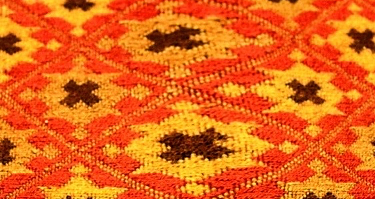
In daily life, women play important roles in family leadership, including participation in their local community decision making. Gender roles are not simplistically aligned with Western assumptions (Kodar et al., 2018). The production of rugs, however, is consistently a matrilineal system. Richard D. Parsons (2016) claimed that boys are increasingly welcomed into weaving in some tribal groups (p. 31), but when I asked Riyaz if male children were allowed to learn weaving, he said that it could be possible but that in the traditional division of camp duties, female children will typically be brought into the activity. He explained that around the time a child is 10 years old, she is tested on the loom, meaning she is assigned to help her mother and/or sisters with a relatively simple project to see if she has the patience and attention to detail required of the craft. Most girls will not prove to have the mindset and disposition to be weavers and so will take up other roles in contributing to family life. Being a weaver is a highly valued role, so when a young person demonstrates promise at the craft, she is trained by her mother and older sisters over the course of many years. Rarely are extended family—even aunts—part of this training. Only if a particular weaver has highly sought after skills or knowledge will the training move beyond the mother–daughter or immediate sisters circle.
Intricate geometric, floral, and animal patterns are memorized and passed from generation to generation as part of oral culture. Riyaz explained that young aspiring weavers learn their craft through being the support weaver on a team, by repeating patterns that a more experienced weaver has already established on a project, or by learning family songs that contain cues to the design. "Weaving" and "yarning" converge to promote tribal memory and belonging through the teaching of these skills and patterns (Tye et al., 2020). Because a family will be constantly producing new rugs for their tents, multiple projects will always be in process. Once a weaver is competent to craft on her own, she may carve out time in her day to work on specific designs of her own desire or inspiration.
Men in the tribal family lead agricultural activities and tend to family affairs throughout the year, and as the 4-month harsh winter retreats and spring arrives, they gather carpets and other textiles that the family no longer wants and take them to village markets where they are bartered for sheep and camp supplies. Those receiving the textiles in trade, in turn, sell them and thereby move them into the marketplace. Riyaz estimated that a large family's rug collection will turn over about once every 10 years, meaning that if 500 rugs are required to outfit a camp, then approximately 50 rugs of varying sizes are produced each year. As a result, rugs entering the market are an average of 10 years old, but some may be either newer or much older. Once these textiles enter into systems of trade, they move farther away from the lives of their weavers. As they travel away from northern Afghanistan and become disconnected with the primary agents of their creation, their origins and meanings fade away, and they are reduced to material commodity.
Much preparation goes into the weaving of a rug, just as much preparation goes into the reading of one. Research into tribal life was fully enriched by Riyaz's expertise while also complemented by numerous outside sources about nomadic life. Using the foundation of basic knowledge now established, the next section (The Shirin Rug) demonstrates application of the proposed framework to reading a specific rug, with the motivating goals of recentering the maker, learning something about her as a situated agent, and amplifying the literacies and technologies that guide her hand.
